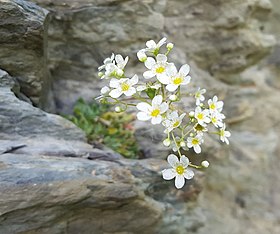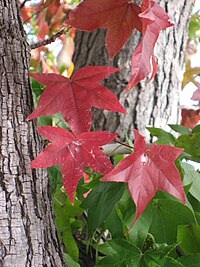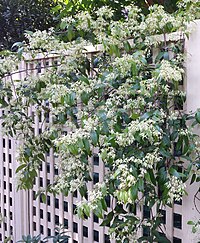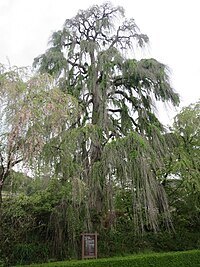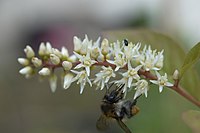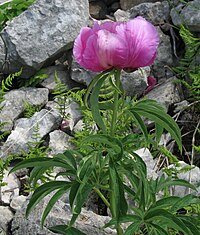Biology:List of Saxifragales families
Saxifragales is an order of 15 families of flowering plants.[lower-alpha 1] It belongs to the superrosids, a group of around 150 related families, including the rose family. The order includes fruit-bearing shrubs, woody vines, succulents, aquatics, and many ornamental trees and garden plants, including stonecrops, currants and witch-hazels.[4][6][7]
Peonies are bred by horticulturists and widely cultivated in temperate gardens.[8] The antiseptic resin of sweetgum trees has been used as a balm since biblical times.[9] Cercidiphyllum japonicum, the largest tree species native to Japan, is used to make boards for the game of Go.[10] Redcurrants, rich in pectin, are used in jams and juices.[11]
Glossary
From the glossary of botanical terms:
- annual: a plant that completes its life cycle (i.e. germinates, reproduces, and dies) within a single year or growing season
- deciduous: shedding or falling seasonally, as with bark, leaves, or petals
- herbaceous: not woody; usually green and soft in texture
- perennial: not an annual or biennial
- succulent (adjective): juicy or fleshy
- unisexual: of one sex; bearing only male or only female reproductive organs[12]
Although these species are quite diverse, there are a few visible traits that can be linked to many of the families. The plants have relatively small seeds, except in the family Peridiscaceae.[13] Flowers tend to have separate, unfused petals, without nectar-secreting glands. The pollen-bearing anthers are often attached by their bases. Most fruits are follicles (seed pods). There are often two distinct ovaries, each with a hypanthium, a tube or cup-like structure in a flower that includes the bases of sepals, petals, and stamens.[14]
Families
| Family and a common name[15][lower-alpha 2] | Type genus and etymology | Total genera; global distribution | Description and uses[lower-alpha 3] | Type genus images |
|---|---|---|---|---|
| Altingiaceae (sweetgum family) | Liquidambar. Altingia, an earlier synonym, was named for Willem Arnold Alting (1724–1800), a Dutch colonial administrator.[17] | 1 genus,[18] in North America and southern, eastern and Southeast Asia[19] | Evergreen and deciduous trees. Several species are harvested for timber. The wood of L. styraciflua is used to make furniture.[19][20][21] | |
| Aphanopetalaceae (gum-vine family) | Aphanopetalum, from Greek for "inconspicuous petals"[22] | 1 genus,[23] in Australia[22] | Shrubs, some twining like vines. The stems have extensive lenticels (ruptures in the bark) for gas exchange.[22] | |
| Cercidiphyllaceae (caramel-tree family) | Cercidiphyllum, from Greek for "leaves like Cercis" (that is, Cercis siliquastrum)[24][25] | 1 genus,[26] in China and Japan[27] | Deciduous trees. The autumn leaves of C. japonicum have a caramel scent.[27] | |
| Crassulaceae (stonecrop family) | Crassula, from Latin for "little thick" (leaves)[28][29][30] | 36 genera,[31] scattered worldwide[32] | Usually herbaceous perennials and annuals, sometimes shrubby, always with succulent stems. Some species of Crassula, Kalanchoe, Hylotelephium, Phedimus and Sempervivum are widely popular as potted ornamentals or rock garden plants. Sedum acre has been used as a pot-herb and a salad green.[32][33][34] | |
| Cynomoriaceae (tarthuth family) | Cynomorium, from Greek for "dog penis"[35] | 1 genus,[36] in arid regions near the Mediterranean and in central and eastern Asia[35] | Reddish-brown herbaceous plant parasites, lacking chlorophyll. C. coccineum has been harvested in deserts for millennia for food and dyes.[35][37] | |
| Daphniphyllaceae (laurel-leaf family) | Daphniphyllum, from Greek for "leaves like Daphne"[38][39] | 1 genus,[40] in southern, eastern and Southeast Asia[10] | Unisexual evergreen shrubs and trees[10] | |
| Grossulariaceae (gooseberry family) | Ribes. Grossularia, an earlier synonym, is from a Latin plant name.[41] | 1 genus,[42] in the temperate Northern Hemisphere and South America[41] | Usually deciduous shrubs, frequently spiny. Most species have edible fruits. Blackcurrant, redcurrant and gooseberry fruits are mixed into juices, preserves and baked goods.[20][41][43] | Ribes rubrum (redcurrant) |
| Haloragaceae (water-milfoil family) | Haloragis, from Greek for "salt berries"[44][45] | 8 genera,[46] distributed almost worldwide[44] | Shrubs, small trees and herbaceous plants, growing in soil and water. Myriophyllum can be cultivated as a pond or aquarium plant.[44][47] | |
| Hamamelidaceae (witch-hazel family) | Hamamelis, from a Greek plant name[48][49][50] | 26 genera,[51] scattered worldwide[52] | Deciduous and evergreen trees and shrubs. Some genera are common garden ornamentals, and some are harvested for furniture-making.[20][52] | |
| Iteaceae (sweetspire family) | Itea, from a Greek plant name[53][54][55] | 2 genera,[56] in North America, southeastern Africa, and eastern and Southeast Asia[57] | Shrubs and trees, usually evergreen. Three species of Itea are grown as garden ornamentals.[20][57][58] | |
| Paeoniaceae (peony family) | Paeonia, from a Greek plant name[59][60] | 1 genus,[61] in temperate western North America and throughout Eurasia[62] | Shrubs and herbaceous perennials. They are widely cultivated as garden ornamentals. P. suffruticosa and P. lactiflora are especially popular in China and Japan.[62][63] | |
| Penthoraceae (ditch-stonecrop family) | Penthorum, from Greek for "five" (fruit sections)[64] | 1 genus,[65] in eastern North America and temperate parts of East Asia[64] | Herbaceous perennials. The plants are edible after cooking, but may have a laxative effect.[64] | |
| Peridiscaceae (ringflower family) | Peridiscus, from Greek for (stamens) "around the disk"[66][67] | 4 genera,[68] in northeastern South America and West and Central Africa[69] | Large shrubs and small trees[20][69] | |
| Saxifragaceae (saxifrage family) | Saxifraga, from Latin for "stone-breaking"[1][2][70] | 40 genera,[71] distributed widely in the Northern Hemisphere, the Andes and New Guinea[72] | Herbaceous perennials, usually, often with rhizomes. Ornamental genera include Astilbe, Bergenia, Darmera, Heuchera, Mukdenia, Rodgersia, Saxifraga, Tellima and Tiarella.[33][72] | |
| Tetracarpaeaceae (delicate-laurel family) | Tetracarpaea, from Greek for "four-fruited"[73] | 1 genus,[74] in Tasmania[73] | Low bushes with erect branches[73] |
See also
- List of alismatid families
- List of commelinid families
- List of lamiid families
- List of lilioid families
Notes
- ↑ The taxonomy (classification) in this list follows Plants of the World (2017)[3] and the fourth Angiosperm Phylogeny Group.[4] Total counts of genera for each family come from Plants of the World Online (POWO).[5] Extinct taxa are not included.
- ↑ Each family's formal name ends in the Latin suffix -aceae and is derived from the name of a genus that is or once was part of the family.[16]
- ↑ For everything cited here from Plants of the World Online (POWO), see their license. Some of POWO's data originally appeared in different databases. After reaching the page for each family, these databases (if any) will appear under the "General information" tab. The databases all focus on description rather than uses.
Citations
Template:Featured list is only for Wikipedia:Featured lists.
- ↑ 1.0 1.1 Coombes 2012, p. 267.
- ↑ 2.0 2.1 Stearn 2002, p. 268.
- ↑ Christenhusz, Fay & Chase 2017.
- ↑ 4.0 4.1 Angiosperm Phylogeny Group 2016.
- ↑ POWO.
- ↑ Christenhusz, Fay & Chase 2017, pp. 10,231–244,415.
- ↑ Wang et al 2009, p. 3853.
- ↑ Christenhusz, Fay & Chase 2017, p. 233.
- ↑ Christenhusz, Fay & Chase 2017, p. 234.
- ↑ 10.0 10.1 10.2 Christenhusz, Fay & Chase 2017, p. 236.
- ↑ Christenhusz, Fay & Chase 2017, p. 244.
- ↑ Christenhusz, Fay & Chase 2017, pp. 638–670.
- ↑ Stevens 2022, Saxifragales.
- ↑ Carlsward et al 2011.
- ↑ Christenhusz, Fay & Chase 2017, pp. 231–244.
- ↑ ICN, art. 18.
- ↑ Burkhardt 2018, p. A-22.
- ↑ POWO, Altingiaceae.
- ↑ 19.0 19.1 Christenhusz, Fay & Chase 2017, pp. 233–234.
- ↑ 20.0 20.1 20.2 20.3 20.4 POWO, Neotropikey.
- ↑ Kubitzki et al 1993, p. 325.
- ↑ 22.0 22.1 22.2 Christenhusz, Fay & Chase 2017, p. 241.
- ↑ POWO, Aphanopetalaceae.
- ↑ Coombes 2012, p. 89.
- ↑ Stearn 2002, p. 88.
- ↑ POWO, Cercidiphyllaceae.
- ↑ 27.0 27.1 Christenhusz, Fay & Chase 2017, pp. 235–236.
- ↑ Coombes 2012, p. 109.
- ↑ Stearn 2002, p. 106.
- ↑ IPNI, Crassulaceae, Type.
- ↑ POWO, Crassulaceae.
- ↑ 32.0 32.1 Christenhusz, Fay & Chase 2017, pp. 239–241.
- ↑ 33.0 33.1 POWO, Flora of West Tropical Africa.
- ↑ Kubitzki et al 2007, p. 96.
- ↑ 35.0 35.1 35.2 Christenhusz, Fay & Chase 2017, pp. 243–244.
- ↑ POWO, Cynomoriaceae.
- ↑ POWO, Flora of Somalia.
- ↑ Coombes 2012, p. 120.
- ↑ Stearn 2002, p. 113.
- ↑ POWO, Daphniphyllaceae.
- ↑ 41.0 41.1 41.2 Christenhusz, Fay & Chase 2017, pp. 237–239.
- ↑ POWO, Grossulariaceae.
- ↑ Kubitzki et al 2007, p. 174.
- ↑ 44.0 44.1 44.2 Christenhusz, Fay & Chase 2017, p. 243.
- ↑ IPNI, Haloragaceae, Type.
- ↑ POWO, Haloragaceae.
- ↑ POWO, Flora of Zambesiaca.
- ↑ Coombes 2012, p. 161.
- ↑ Stearn 2002, p. 160.
- ↑ IPNI, Hamamelidaceae, Type.
- ↑ POWO, Hamamelidaceae.
- ↑ 52.0 52.1 Christenhusz, Fay & Chase 2017, pp. 234–235.
- ↑ Coombes 2012, p. 178.
- ↑ Stearn 2002, p. 177.
- ↑ IPNI, Iteaceae, Type.
- ↑ POWO, Iteaceae.
- ↑ 57.0 57.1 Christenhusz, Fay & Chase 2017, pp. 236–237.
- ↑ Kubitzki et al 2007, p. 203.
- ↑ Coombes 2012, p. 222.
- ↑ Stearn 2002, p. 228.
- ↑ POWO, Paeoniaceae.
- ↑ 62.0 62.1 Christenhusz, Fay & Chase 2017, p. 232.
- ↑ Kubitzki et al 2007, p. 268.
- ↑ 64.0 64.1 64.2 Christenhusz, Fay & Chase 2017, pp. 242–243.
- ↑ POWO, Penthoraceae.
- ↑ Quattrocchi 2019, p. 2010.
- ↑ IPNI, Peridiscaceae, Type.
- ↑ POWO, Peridiscaceae.
- ↑ 69.0 69.1 Christenhusz, Fay & Chase 2017, pp. 231–232.
- ↑ IPNI, Saxifragaceae, Type.
- ↑ POWO, Saxifragaceae.
- ↑ 72.0 72.1 Christenhusz, Fay & Chase 2017, pp. 238–239.
- ↑ 73.0 73.1 73.2 Christenhusz, Fay & Chase 2017, p. 242.
- ↑ POWO, Tetracarpaeaceae.
References
- Angiosperm Phylogeny Group (2016). "An update of the Angiosperm Phylogeny Group classification for the orders and families of flowering plants: APG IV". Botanical Journal of the Linnean Society 181 (1): 1–20. doi:10.1111/boj.12385.
- Burkhardt, Lotte (2018) (in German) (pdf). Verzeichnis eponymischer Pflanzennamen – Erweiterte Edition. Berlin: Botanic Garden and Botanical Museum, Freie Universität Berlin. doi:10.3372/epolist2018. ISBN 978-3-946292-26-5. https://doi.org/10.3372/epolist2018. Retrieved January 1, 2021. See the licence.
- Carlsward, Barbara S.; Judd, Walter S.; Soltis, Douglas E.; Manchester, Steven; Soltis, Pamela S. (2011). "Putative Morphological Synapomorphies of Saxifragales and Their Major Subclades". Journal of the Botanical Research Institute of Texas 5 (1): 179–196. ISSN 1934-5259. https://www.researchgate.net/publication/264403780.
- Christenhusz, Maarten; Fay, Michael Francis; Chase, Mark Wayne (2017). Plants of the World: An Illustrated Encyclopedia of Vascular Plants. Chicago, Illinois: Kew Publishing and The University of Chicago Press. pp. 18–637. ISBN 978-0-226-52292-0.
- Coombes, Allen (2012). The A to Z of Plant Names: A Quick Reference Guide to 4000 Garden Plants. Portland, Oregon: Timber Press. ISBN 978-1-60469-196-2.
- IPNI (2022). "International Plant Names Index". London, Boston and Canberra: Royal Botanic Gardens, Kew; Harvard University Herbaria & Libraries; and the Australian National Botanic Gardens. https://www.ipni.org.
- Kubitzki, K. et al. (1993). The Families and Genera of Vascular Plants. II Flowering plants - Dicotyledons. Magnoliid, Hamamelid and Caryophyllid families. II. Berlin: Springer. ISBN 3-540-55509-9. https://books.google.com/books?id=yjlzrzbRXNQC.
- Kubitzki, K. et al. (2007). Kubitzki, K.. ed. Berberidopsidales, Buxales, Crossosomatales, Fabales p.p., Geraniales, Gunnerales, Myrtales p.p., Proteales, Saxifragales, Vitales, Zygophyllales, Clusiaceae Alliance, Passifloraceae Alliance, Dilleniaceae, Huaceae, Picramniaceae, Sabiaceae. IX. ISBN 978-3-540-32214-6. https://books.google.com/books?id=PdSL7jBNX9EC.
- POWO (2019). "Plants of the World Online". London: Royal Botanic Gardens, Kew. http://www.plantsoftheworldonline.org/. See their terms-of-use license.
- Quattrocchi, Umberto (2019). CRC World Dictionary of Plant Names, Volume III, M–Q. Boca Raton, Florida: CRC Press. ISBN 978-0-367-44751-9.
- Stearn, William (2002). Stearn's Dictionary of Plant Names for Gardeners. London: Cassell. ISBN 978-0-304-36469-5.
- Stevens, P.F. (2022). "Angiosperm Phylogeny Website.". Missouri Botanical Garden. http://www.mobot.org/mobot/research/APWeb/.
- Turland, N. J., ed. International Code of Nomenclature for algae, fungi, and plants (Shenzhen Code) adopted by the Nineteenth International Botanical Congress Shenzhen, China, July 2017 (electronic ed.). Glashütten: International Association for Plant Taxonomy. https://www.iapt-taxon.org/nomen/pages/main/art_18.html. Retrieved February 25, 2022.
- Wang, Hengchang; Moore, Michael J.; Soltis, Pamela S.; Bell, Charles D. (March 10, 2009). "Rosid radiation and the rapid rise of angiosperm-dominated forests". Proceedings of the National Academy of Sciences 106 (10): 3853–3858. doi:10.1073/pnas.0813376106. PMID 19223592. Bibcode: 2009PNAS..106.3853W.
